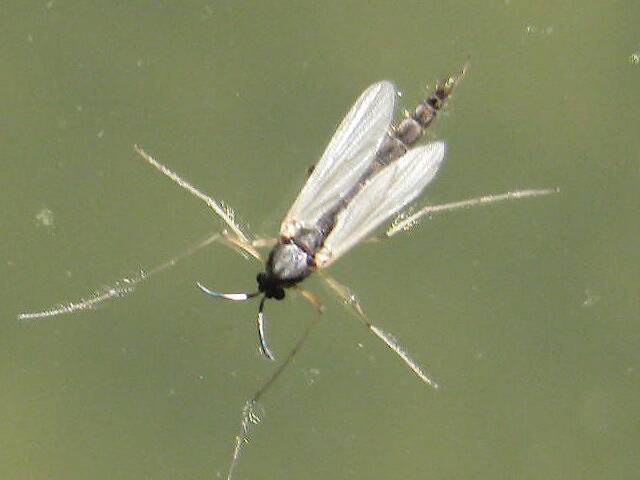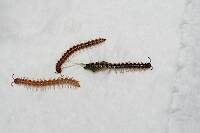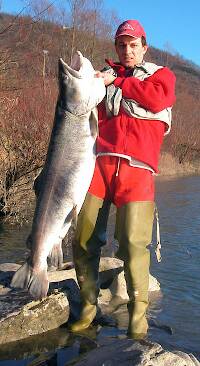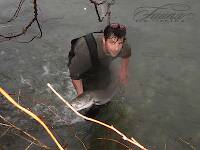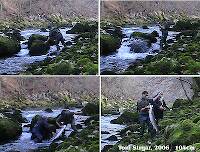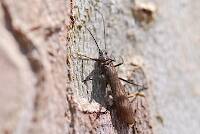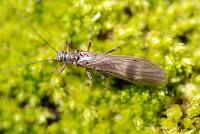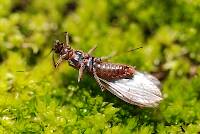
Blue-winged Olives
Baetis
Tiny Baetis mayflies are perhaps the most commonly encountered and imitated by anglers on all American trout streams due to their great abundance, widespread distribution, and trout-friendly emergence habits.
Featured on the forum

This one was surprisingly straightforward to identify. The lack of a sclerite at the base of the lateral hump narrows the field quite a bit, and the other options followed fairly obvious characteristics to Clostoeca, which only has one species, Clostoeca disjuncta.

Troutnut is a project started in 2003 by salmonid ecologist Jason "Troutnut" Neuswanger to help anglers and
fly tyers unabashedly embrace the entomological side of the sport. Learn more about Troutnut or
support the project for an enhanced experience here.
Falsifly on Apr 10, 2013April 10th, 2013, 1:19 pm EDT
It is generally accepted that in order to help oxygenate a fish’s blood/oxygen content level before release from a stressful encounter that we aid the flow of water over the gills. This is typically performed by gently grasping the fish just ahead of the caudal fin and rhythmically producing a reciprocating motion to the fish as it lies placidly in the water then releasing the grip when the fish begins to struggle. If considering the (counter current system) and the fish’s respiratory rate (timing) of water from mouth thru gills process could this be counterproductive?
Consider the following scenarios:
(1) Pushing the fish forward when the mouth is closed.
I see no gain.
(2) Pushing the fish forward as the mouth is opening.
I see little gain as the expanded mouth volume is fixed.
(3) Pushing the fish forward as the mouth is closing and the gill plates are opening.
I see a possible gain.
(4) Pulling the fish backward when the mouth is closed.
I see no gain
(5) Pulling the fish backward when the mouth is opening.
I see no gain at best and a possible hindrance.
(6) Pulling the fish backward when the mouth is closing and the gill plates are opening.
I see this as the worst case scenario. Water pressure is increased at the gill plate opening countering the increased pressure provided by the decreasing mouth volume which provides the means of water flowing through the gills and reduces the effectiveness of the “counter current system”.
What am I misunderstanding?
The blood flows through the gill filaments and secondary lamellae in the opposite direction from the water passing the gills. This is a counter current system and is very important for getting all of the available oxygen out of the water and into the blood.
Consider the following scenarios:
(1) Pushing the fish forward when the mouth is closed.
I see no gain.
(2) Pushing the fish forward as the mouth is opening.
I see little gain as the expanded mouth volume is fixed.
(3) Pushing the fish forward as the mouth is closing and the gill plates are opening.
I see a possible gain.
(4) Pulling the fish backward when the mouth is closed.
I see no gain
(5) Pulling the fish backward when the mouth is opening.
I see no gain at best and a possible hindrance.
(6) Pulling the fish backward when the mouth is closing and the gill plates are opening.
I see this as the worst case scenario. Water pressure is increased at the gill plate opening countering the increased pressure provided by the decreasing mouth volume which provides the means of water flowing through the gills and reduces the effectiveness of the “counter current system”.
What am I misunderstanding?
Falsifly
When asked what I just caught that monster on I showed him. He put on his magnifiers and said, "I can't believe they can see that."
When asked what I just caught that monster on I showed him. He put on his magnifiers and said, "I can't believe they can see that."
Sayfu
Posts: 560
Posts: 560
Sayfu on Apr 10, 2013April 10th, 2013, 2:34 pm EDT
I saw a guide in Quebec highly recommend stroking your hand on an Atlantic Salmons stomach back towards the head to remove air from the body cavity before release while holding the fish in the water. I'd never seen, or heard of that before.
Konchu on Apr 10, 2013April 10th, 2013, 4:58 pm EDT
The countercurrent exchange system is a way that the fish's circulatory system takes advantage of the physics of diffusion to get the most oxygen out of the water (and to get rid of the most carbon dioxide). The most oxygen-starved blood is exposed to the least oxygenated water and the most oxygen-rich blood is exposed to the most oxygenated water (this is a progressive process). Either way, oxygen will enter the bloodstream via passive diffusion, because there will be relatively more oxygen (or less carbon dioxide) outside the fish's bloodstream at that point. Sometimes this correlates with flow of water around the main body of the fish; other times, it may not. It depends on the natural direction of flow of the water over the particular structure that contains the capillary that contains the blood. Fish are pretty good at moving the water by themselves to generate the necessary water flow. I don't know that pushing or pulling the fish will make much difference, but I could be wrong. I'd actually be concerned about introducing more stress. Maybe someone can show me where I might be wrong. If you find an error in my explanation, don't hesitate to point it out either. It's been a long day and a few weeks since we covered this in class...
Falsifly on Apr 10, 2013April 10th, 2013, 5:55 pm EDT
It depends on the natural direction of flow of the water over the particular structure that contains the capillary that contains the blood.
So in the case of the gill structure and the direction of the blood flow through the capillary system this "natural direction of flow" of the water would be thru the mouth and out thru the gills. Should the water flow direction be hindered or reversed I would think that the gas diffusion process would be less efficient. That is point I'm trying to get at.
Falsifly
When asked what I just caught that monster on I showed him. He put on his magnifiers and said, "I can't believe they can see that."
When asked what I just caught that monster on I showed him. He put on his magnifiers and said, "I can't believe they can see that."
Jmd123 on Apr 10, 2013April 10th, 2013, 7:18 pm EDT
In streams I hold them facing upstream in the current until they can swim on their own. In standing waters I just hold them gently and let their gill pumping do the work.
Jonathon
Jonathon
No matter how big the one you just caught is, there's always a bigger one out there somewhere...
Martinlf on Apr 11, 2013April 11th, 2013, 3:51 am EDT
It's my understanding that pulling the fish back and forth is counterproductive, as Konchu and Falsify suggest, and that Jonathan's approach is better. I've never heard of the method Sayfu describes that guide using. Jason?
"He spread them a yard and a half. 'And every one that got away is this big.'"
--Fred Chappell
--Fred Chappell
Konchu on Apr 11, 2013April 11th, 2013, 5:22 am EDT
Perhaps moving the fish around would stimulate it to start moving water past its gills, if it had stopped doing so due to stress or shock.
Jmd123 on Apr 11, 2013April 11th, 2013, 3:24 pm EDT
I think in general if a fish isn't even trying to pump its gills, it's gone to meet it's maker, so to speak. No matter how exhausted any fish I've ever caught is, it still seems to be able to work its gills. Just gotta get the head back in the water ASAP!
Jonathon
Jonathon
No matter how big the one you just caught is, there's always a bigger one out there somewhere...
Quick Reply
Related Discussions
Topic
Replies
Last Reply
2
Sep 11, 2010
by Adirman
by Adirman
4
May 14, 2012
by Crepuscular
by Crepuscular


